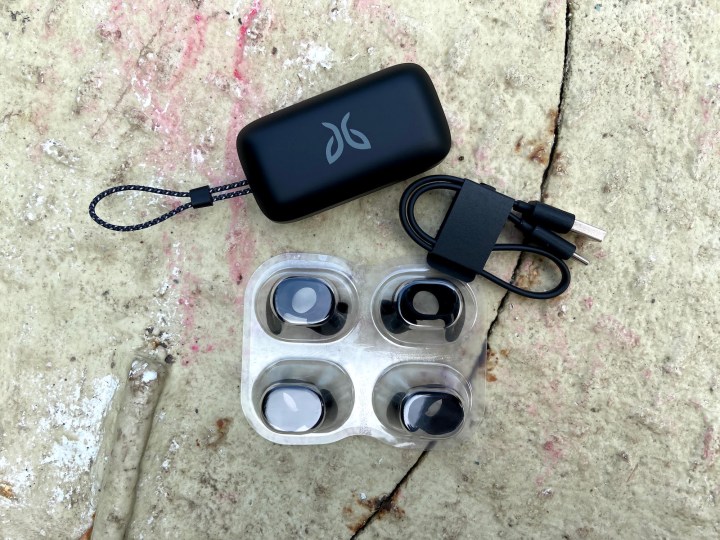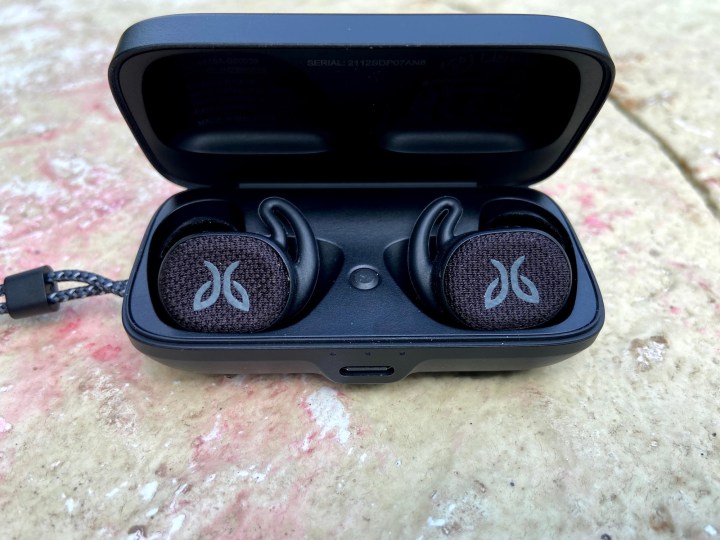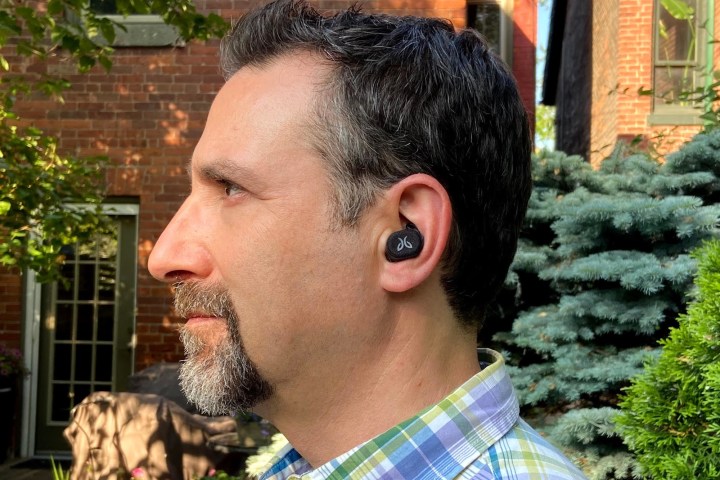- Fully water and dustproof
- Compact and secure fit
- Great sound quality
- Wireless charging
- Very poor call quality
- ANC struggles with wind noise
We were pretty impressed with Jaybird’s Vista when they launched in 2019. As the company’s third attempt at creating a top-notch, athlete-friendly set of true wireless earbuds, the $150 Vista (which debuted at $180) handily succeeded where the previous Jaybird Run and Run XT didn’t.
They sounded great and featured a compact and rugged design. But time waits for no one, and in 2021, if you want to be the best running headphones, or simply the best for any kind of intense activity, you need more. Way more. Can Jaybird’s new $200 Vista 2 claim that distinction? Let’s find out.
Editor’s note: A few months after we published this review, Jaybird dropped the price of the Vista 2 from $200 to $150. Given such a big price drop, we felt these earbuds deserved a better score, so we increased it from a 7/10 to an 8/10.
What’s new?
If you’re familiar with the original Jaybird Vista, and you’re wondering what an extra $50 investment gets you, here’s what’s new with the Vista 2:
- Active noise cancellation (ANC) and transparency modes
- Longer battery life
- Wear sensors for music autopause
- Better dust and water resistance
- AAC Bluetooth codec support
- Wireless charging
- “Find my” function for each earbud and the charging case
What’s in the box?

Inside the box, which is almost completely recyclable, you’ll find the Vista 2 earbuds already in their charging case, a USB-A to USB-C cable for charging, three sizes of eartips (Jaybird calls them “eargels”), and some paper documentation.
Design

Sport-oriented earbuds are often bulky affairs, but Jaybird has stayed true to the Vista’s highly pocketable design.
You know the expression “if it ain’t broke, don’t fix it,” and that sums up Jaybird’s approach to the Vista 2. Put them side by side with the original Vista and you can see that much has been preserved. They have the same compact and ergonomic shape, the same style of eargels with the integrated stabilizer fins, and an almost identical charging case, though the new one has more rounded contours. But Jaybird eliminated the small indentation on the front edge of the lid, which makes it harder to open the case, especially with sweaty or wet fingers.
Sport and fitness-oriented earbuds are often bulky affairs with big earhooks and even bigger charging cases. It’s great to see that Jaybird has stayed true to the highly pocketable design it created with the Vista.
Also preserved (and improved) is the Vista’s class-leading durability. In addition to meeting the MIL-STD-810 standard for environmental durability, the earbuds now feature an IP68 rating for total dust and water protection, while the charging case gets its own IP54 rating. Bear in mind that the earbuds don’t float and Bluetooth signals don’t travel well through water, so swimming with them is not recommended. For fun, I let the earbuds sit at the bottom of a sink full of water. When I plucked them out 30 minutes later, they seemed to be just fine.
The charging case contacts are corrosion resistant, so all you need to do is wipe away any excess water and you’re good to go. The case can now charge wirelessly, which is an especially big convenience if you own a phone that can perform reverse-wireless charging for accessories, like Samsung’s Galaxy S21.
The most visible difference is the woven fabric that now covers the outer portion of the earbuds. Jaybird calls it “WindDefense” fabric and, as that name implies, it’s meant to act as a wind sock, preventing wind and other sounds from interfering with the microphones.
Under that fabric is a physical button that can be used to trigger the usual actions like controlling playback, track selection, etc., but now each earbud also has an embedded accelerometer sensor for tap controls.
Comfort, controls, and connections

Given the choice between earbuds with earhooks, like the Powerbeats Pro, and earbuds with internal stabilizer fins like the Vista 2, I will go with the stabilizer fins every time. While it’s true that they’re slightly less comfortable initially when you insert them, they’re easier to put on, and there’s no hook to interfere with my glasses. That’s not to mention how much smaller they are!
You may not want to wear them for endless hours, but they’re more than comfy enough for a two-hour workout.
As for the secureness of fit, don’t worry: With the combination of the stabilizer fins and the cone shape of the silicone eartips, the Vista 2 are very hard to accidentally dislodge. If anything, they can be a bit tricky to remove thanks to the incredible seal created by the eargels. You may not want to wear them for endless hours, but they’re more than comfy enough for a two-hour workout.
Beneath that fabric exterior, the hidden buttons click with a satisfying feel, and the free Jaybird app lets you pick specific functions for each click sequence on each earbud. When you include the three click types (single, double, click-and-hold) and the optional double-tap gesture, that’s eight options, more than enough to cover playback, track skipping, volume, ANC mode, and more. My one minor quibble is the volume control. It’s only accessible via the click-and-hold gesture, which I find too imprecise for volume adjustments. You’re probably better off using your phone’s controls for this.
The double-tap gesture, which is primarily used to switch between ANC and transparency (or “SurroundSense” as Jaybird likes to call it), is also reasonably responsive, though I did experience a few times where I needed to repeat it using a slower cadence.
The built-in wear sensors (new for the Vista 2) let you autopause your music when you remove an earbud (and resume it when you pop it back in). It can be turned on or off in the app, and I found it responded very quickly to changes.
It’s fun to browse the various sound recipes that others have discovered and shared.
Jaybird claims that as a class 2 Bluetooth device, the Vista 2 can get about 33 feet away from a phone or tablet before it drops the connection. Outdoors, this is certainly true. When inside, it’s more like 20 feet depending on the obstacles between the earbuds and their source device.
And yes, you can use each earbud independently if you need to, for music or phone calls.
Sound quality
Despite being geared toward athletes, who, let’s face it, are not just sitting around for critical listening sessions, the Vista 2 sound great. Out of the box, the signature is balanced, if a bit tame, but once you jump into the Jaybird app and start tweaking the EQ, these earbuds really shine.
Simply switching from the default “flat” EQ to the Signature setting was enough to boost the overall dynamic range considerably, and it also helped to bring out detail in the midranges and high frequencies while also delivering punchy bass.
Speaking of EQ, one of Jaybird’s most interesting features is its social sound settings. Users can create their own particular EQ setting, name it, and share it with other Jaybird users. I suspect that most folks will find the handful of built-in EQ options sufficient, but it’s fun to browse the various sound recipes that others have discovered and shared.
There’s also a personal EQ feature that creates settings based on the frequencies you can hear. I ended up preferring the built-in settings, but it’s a nice extra.
As you would expect from workout earbuds, there’s tons of low-end bass on tap. And though this sometimes gets a little exuberant, muddying the midranges at times, those EQ settings can help dial in exactly how much boom should accompany your activity.
Noise cancellation and transparency

The Jaybird Vista did a good job with passive noise isolation thanks to those snug-fitting eargels, but the Vista 2 kick it up a notch with the addition of ANC. It’s not a massive cone-of-silence change when you turn it on, but it’s exactly what you need to reduce outside sounds to the point where they no longer intrude on your concentration.
Jaybird’s SurroundSense transparency mode lets you adjust how much sound should be let in, and the degree to which it should attempt to compensate for wind noise (low, medium, or high). When engaged (a double tap on either earbud), you can have very normal conversations with those around you, or simply increase your awareness of traffic and other potential hazards. I really appreciate that you can decide if you want that double tap to switch between off, ANC, and transparency, or any two of these modes.
There is one drawback, however, and it’s a big one: Wind noise isn’t canceled at all, and in fact I’d argue it’s more noticeable with ANC on than when it’s off. Considering Jaybird specifically set out to deal with this via its WindDefense fabric, it’s especially disappointing.
Call quality

As long as you’re in a quiet location indoors, or outdoors on a very calm day, call quality on the Jaybird Vista 2 is good enough for most types of calls.
But when even a slight breeze is present, that wind sound totally obliterates your voice. Again, it’s really odd considering the presence of that WindDefense fabric, not to mention the fact that these earbuds are, in every other way, totally designed for life outside. If you’re wondering why these earbuds only scored 3.5 stars on our rating scale, this is the biggest reason.
Jaybird tells me it will continue to update its firmware to improve call quality, but there’s a limit to what it can do given the microphone placement on the Vista 2.
Find my earbuds
Most earbuds that have a “find my” feature typically just give you a way to make the earbuds emit a high-pitched wail so you can find them between the couch cushions. Jaybird also does this, but goes a step further by showing you, on a map, the location of each earbud plus the charging case — something it can do because the case actually has its own Bluetooth beacon.
The Jaybird app dutifully displayed the earbuds and case on a map, but I couldn’t get it to force a locating sound from the earbuds. Hopefully, this will be fixed with a firmware update.
Battery life
The original Vista did not boast especially impressive battery life numbers (six hours per earbud and 10 more hours in the charging case). The Vista 2 improve on this considerably with a claimed eight hours per earbud and 16 hours in the case. Fast charging remains the same: Five minutes will get you an extra hour of playing time.
With volume set to 50% and ANC turned on, the earbuds tapped out after six hours. Turning ANC off should get you up to the claimed eight-hour figure, but I didn’t test this.
Our take
The only thing holding the Jaybird Vista 2 back from being the perfect workout earbuds is their terrible phone call quality. Otherwise, they absolutely nail it, providing serious competition for the Powerbeats Pro.
Is there a better alternative?
The Vista 2 hit a sweet spot in terms of features and price, with no direct competitors. However, for $150, the JBL Reflect Mini NC give you almost all of the Vista 2’s capabilities and they have way better call quality. They lack wireless charging, they don’t last as long on a charge, and they aren’t as tough as the Vista 2, but they give you a choice of voice assistants.
If you’re a die-hard Apple fan and want the ability to summon Siri hands-free, the Powerbeats Pro are still a very good choice, but their large earhooks and lack of ANC or wireless charging make their $249 regular price seem unnecessarily steep.
How long will they last?
Given the Vista 2’s incredible protection from water, dust, and other kinds of damage, they should last for many years of regular use. Batteries are always the big unknown, but there’s no reason to think that the Jaybird Vista 2 will be any better or worse than other brands. Jaybird backs the Vista 2 with a one-year warranty.
Should you buy them?
Yes — that is if you can see past their awful call quality. If calls don’t matter, the Jaybird Vista 2 are great-sounding workout earbuds that are tough as nails.










